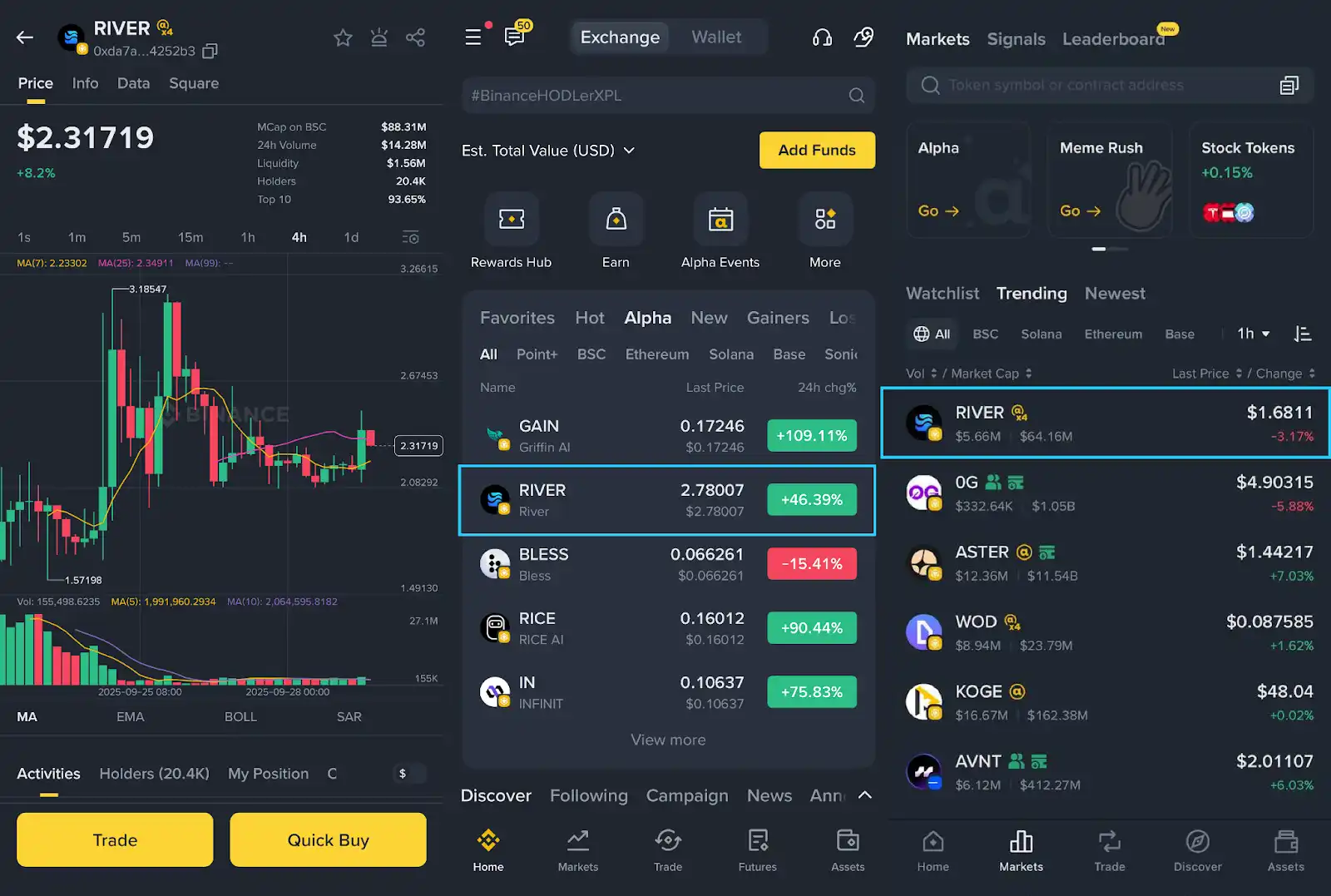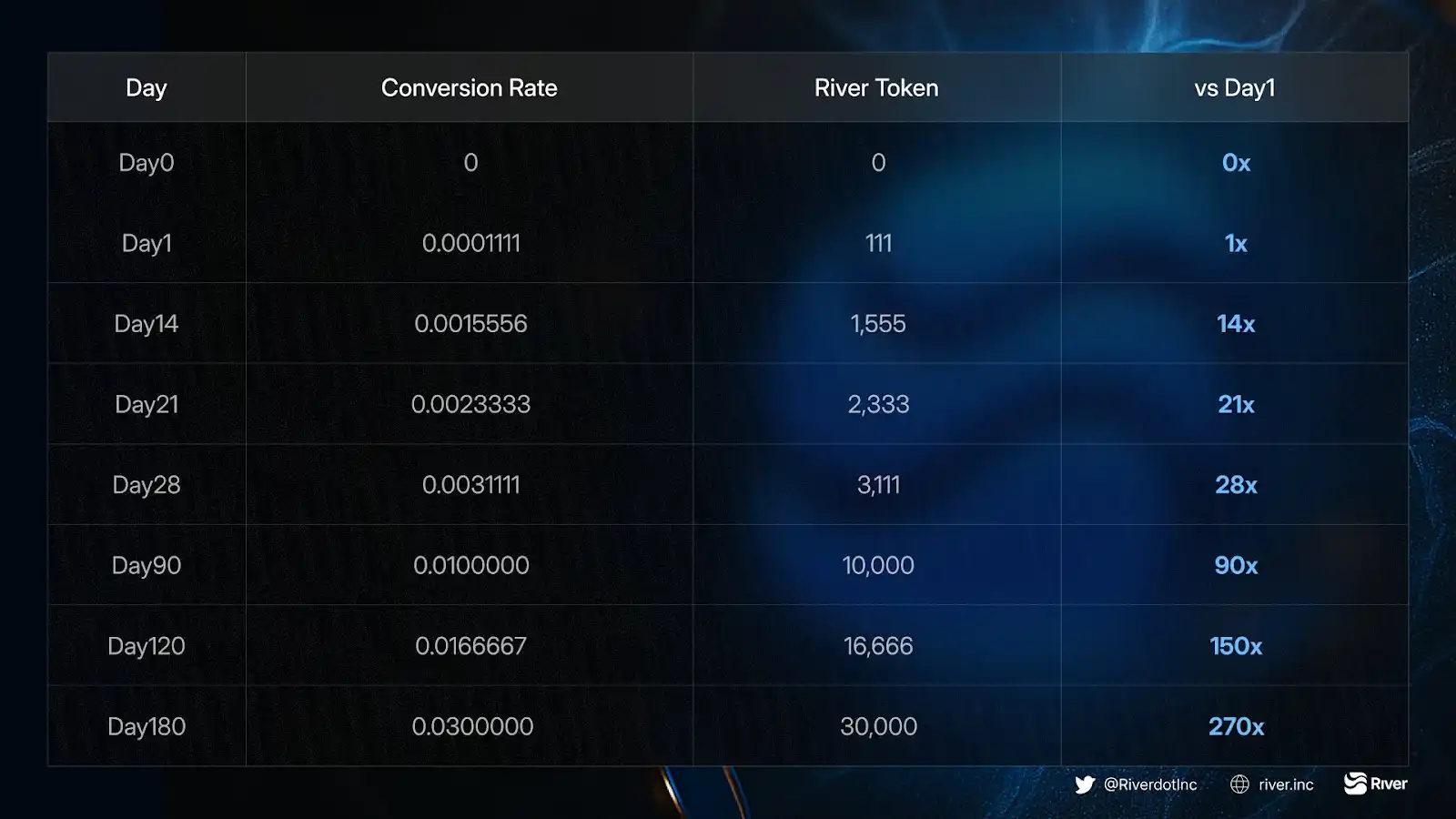Original source: Binance Wallet
On September 19, 2025, Binance Wallet launched the brand new BuildKey TGE mechanism, with $RIVER as the first project to go live. This model differs from previous Binance Wallet IDOs or Alpha launches, as BuildKey TGE adopts a three-phase design of "subscription → pre-trade → formal exchange," providing market pricing and exit opportunities for tokens before they officially go live for trading.
The first project of Binance Wallet's new mechanism, $RIVER, saw a total of $100 million in subscriptions within the first 2 hours of deposit opening, ultimately oversubscribed by 993 times, setting a new historical record for Binance Wallet IDOs.

$RIVER Continues to Rise, IDO User Returns Reach Up to 6200%
On September 25, after $RIVER went live on Binance Alpha, it quickly surged, reaching a high of $3.1, an increase of 6200% compared to the IDO price, and it was also listed on several international trading platforms such as Bitget.

Data shows that within 24 hours of going live, the spot trading volume exceeded $150 million, with the number of holding addresses reaching 28,000. Additionally, it ranked second on the main site of Binance Alpha for three consecutive days, indicating user expectations for trading in this new model and project.
Dynamic Airdrop Conversion: Writing "Time" into Tokenomics
In addition to being the first project of Binance Wallet's new mechanism, River sparked market discussions during its TGE with the Dynamic Airdrop Conversion mechanism. This mechanism allows users to freely choose the timing of their exchange within 180 days; the later the conversion, the more tokens received. In other words, users must choose between "immediate exit" and "long-term holding."
This is the first project mechanism to incorporate "time" as a core variable in Tokenomics. Initially, the system reserved 1 billion River Pts, representing 30% of the total supply, or 30 million RIVER. Each participant faces the same choice: redeem on Day 1? Or Day 90? Or wait until the last day? You can convert all at once or in batches.
The real key is that the ratio is not fixed but increases over time. The longer you wait, the more RIVER tokens you can redeem for your River Pts. Suppose you currently hold 1M (one million) River Pts; the number of RIVER tokens you can redeem will vary depending on whether you redeem on Day 1, Day 90, or Day 180.

Supporters believe this mechanism can avoid concentrated selling pressure from airdrops and encourage long-term participation; critics question whether this is a disguised lock-up by the project party. However, there are also arbitrageurs discussing the price of River Pts and the arbitrage opportunities that change over time—should one choose to exit immediately or increase participation?
River Pts, as a tradable ERC20 Token, can also be traded on DEXs (decentralized exchanges); currently, the market is a mix of long-term and short-term views, engaging in a dynamic game between the current price of River Pts and future conversion expectations.
River Protocol: Infrastructure for Chain Abstract Stablecoins
It is worth noting that $RIVER is not just a simple token but an entire protocol—River. River is the first chain abstract stablecoin system, aiming to connect different ecosystems and users, redefining the relationship between assets and opportunities. Its core module, Omni-CDP, allows users to deposit BTC, ETH, BNB, or LST (liquid staking tokens) on Chain A and natively mint satUSD on Chain B, directly obtaining liquidity and participating in yield opportunities.
Currently, there are over 400 Layer 2 networks, more than 30 stablecoins, and over 20 LSD/LST (liquid staking derivatives/tokens) in the market. While it seems prosperous, capital is actually trapped on its own islands.
Data shows that River has accumulated $700 million in TVL (Total Value Locked) and $280 million in circulating satUSD within just two months, ranking 24th in the DeFiLlama stablecoin leaderboard. The Smart Vault product, based on Omni-CDP technological innovation, attracted a total of $10 million USDT deposits within 12 hours of its first launch, demonstrating market recognition.
After the TGE, the project quickly launched the institutional-grade product Prime Vault, released on the Base chain and integrated with the Morpho protocol, indicating that the project is systematically expanding its stablecoin infrastructure to a larger ecosystem and application scenarios.
Why It’s Worth Noting?
In summary, the TGE of $RIVER brought three highlights worth noting:
As the first project of Binance Wallet's new mechanism, the total subscription amount reached $100 million, oversubscribed by 993 times;
The innovation of Dynamic Airdrop Conversion sparked a game between long-term holding and short-term cashing out;
The price of $RIVER tokens continues to reach new highs, driving user behavior incentivized by River Pts, forming a positive cycle.
The combination of these three factors makes $RIVER one of the most representative TGE cases of 2025. Whether this model can become an industry standard remains to be seen; however, it is certain that this experiment has left a new coordinate in the narrative of airdrop mechanisms and token economics.
This article is from a submission and does not represent the views of BlockBeats.
免责声明:本文章仅代表作者个人观点,不代表本平台的立场和观点。本文章仅供信息分享,不构成对任何人的任何投资建议。用户与作者之间的任何争议,与本平台无关。如网页中刊载的文章或图片涉及侵权,请提供相关的权利证明和身份证明发送邮件到support@aicoin.com,本平台相关工作人员将会进行核查。


